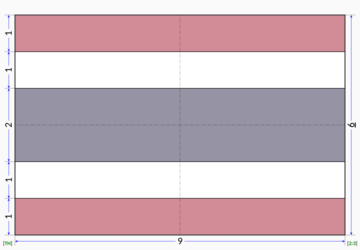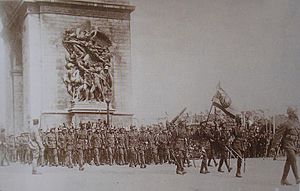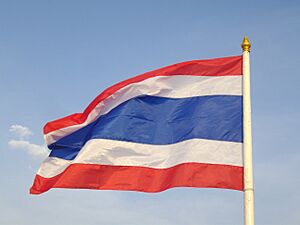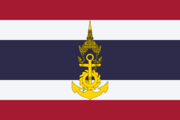Flag of Thailand facts for kids
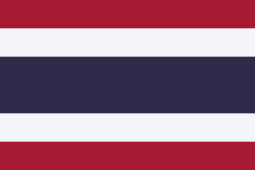 |
|
| Name | Trairanga (Thai: ธงไตรรงค์, RTGS: thong trai rong), 'Tricolour flag' |
|---|---|
| Use | National flag, civil and state ensign |
| Proportion | 2:3 |
| Adopted | 28 September 1917 (standardized on 30 September 2017) |
| Design | Five horizontal stripes of red, white, blue, white and red, the middle stripe twice as wide as the others |
| Designed by | King Vajiravudh (Rama VI) |
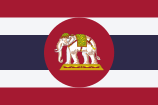
Variant flag of Kingdom of Thailand
|
|
| Name | Thai: ธงราชนาวี (RTGS: thong ratcha nawi), 'Royal Navy flag' |
| Use | Naval ensign |
| Proportion | 2:3 |
| Adopted | 28 September 1917 (de jure) |
| Design | A red disc containing a white elephant (Airavata) in regalia centered on the national flag |
The flag of Thailand is called the Trairanga (Thai: ธงไตรรงค์). This means 'tricolour flag' in Thai. It has five horizontal stripes. The colours are red, white, blue, white, and red. The blue stripe in the middle is twice as wide as the other four stripes.
This flag design was officially chosen on 28 September 1917. King Rama VI made this decision. Since 2016, September 28th is a special national holiday in Thailand. It is called Flag Day and celebrates the flag.
The colours of the flag have special meanings. They stand for "nation-religion-king," which is an important idea in Thailand.
- Red represents the land and the people of Thailand.
- White stands for the religions in the country.
- Blue represents the monarchy (the king and royal family). Blue was also a special colour for King Rama VI.
When the king declared war on Germany in July 1917, the flag's colours became similar to those of other countries. These included the United Kingdom, France, Russia, and the United States. These countries were allies during World War I.
Contents
What the Flag Looks Like
The Thai flag is shaped like a rectangle. Its width is 6 parts and its length is 9 parts. It has five stripes that go all the way across.
- The middle stripe is 2 parts wide and is deep blue.
- Next to the blue stripe on each side are white stripes, each 1 part wide.
- On the very outside, next to the white stripes, are red stripes, each 1 part wide.
This design makes the blue stripe stand out as the widest.
How the Colours are Set
The exact colours for the flag were made official on 30 September 2017. This was to celebrate 100 years since the flag was first adopted. These standards help make sure all physical flags have the correct colours.
History of the Thai Flag
The very first flag used for Siam (the old name for Thailand) was likely a plain red flag. This was probably used around the time of King Narai (1656–1688). Later, naval flags (flags used on ships) had different symbols on the red background. These symbols included a white chakra (a wheel symbol) or a white elephant. The elephant, named Airavata, is a famous elephant from Hindu stories.
In 1855, King Mongkut (Rama IV) created the first official flag. It showed a white elephant on a red background. The plain red flag was not unique enough for talking with other countries.
In 1916, the flag changed again. It now showed a white elephant wearing royal decorations. Later that same year, a new design was created for civilian ships. This design was similar to today's flag, but the middle stripe was red, not blue.
A popular story says that King Vajiravudh (Rama VI) was upset when he saw someone accidentally fly the elephant flag upside down. To prevent this, he ordered a new flag design that would look the same even if it was flown upside down. This led to the five-stripe design.
At first, in 1916 and 1917, this new flag only had red and white stripes. But later in 1917, the middle stripe was changed to dark blue. This blue colour was special because it was the lucky colour for Saturday, the day King Vajiravudh was born. Also, some say the blue colour was chosen to show that Thailand was working with the Allies of World War I (like the UK, France, and USA). These countries also had blue, red, and white in their flags.
Timeline of Thai Flags
| Flag | Date | Use | Description |
|---|---|---|---|
| c. 1680 – c. 1782 | A plain red rectangular flag. | ||
| c. 1782–1855 | |||
| c. 1782 – c. 1817 | A red flag with a white chakra (wheel symbol). This likely represented the Chakri dynasty (the royal family). | ||
| c. 1817–1855 | A red flag with a white elephant inside the chakra. | ||
| c. 1843–1855 | A white elephant, facing the left side of the flag, in the middle of a red background. This flag was known as Thong Chang Puak. | ||
| 1855–1893 | |||
| 1893–1916 | |||
| 1893–1898 | A white elephant wearing royal decorations, facing the left side, in the middle of a red background. | ||
| 1898–1912 | |||
| 1912–1917 | |||
| 1916–1917 | A red flag with two horizontal white stripes. Each white stripe was one-sixth of the flag's width, placed one-sixth from the top and bottom edges. | ||
| 1917–present | The flag with a horizontal blue stripe (one-third wide) between white stripes (one-sixth wide), which are between red stripes (one-sixth wide). This is known as the Trairanga. |
The naval flag of the Royal Thai Navy (RTN) is the national flag with a red circle in the middle. This circle reaches the red stripes at the top and bottom. Inside the red circle is a white elephant, dressed in full royal gear, facing the left side of the flag.
The naval jack (a flag flown at the bow of a ship) of Thailand is the national flag with the symbol of the Royal Thai Navy in the middle. Both these naval flags were adopted in 1917.
See also
 In Spanish: Bandera de Tailandia para niños
In Spanish: Bandera de Tailandia para niños


